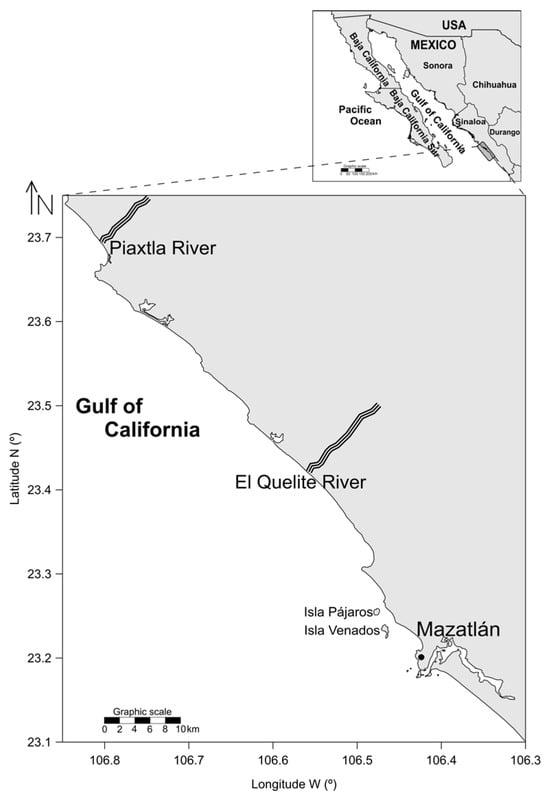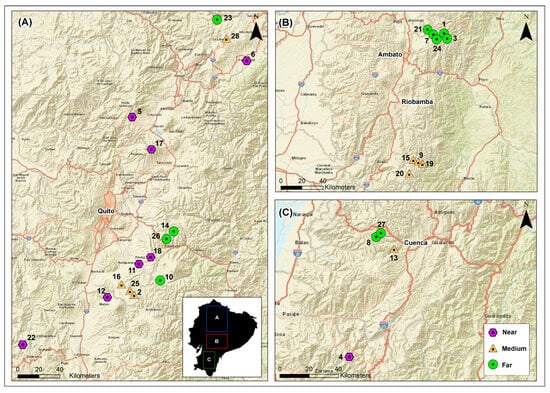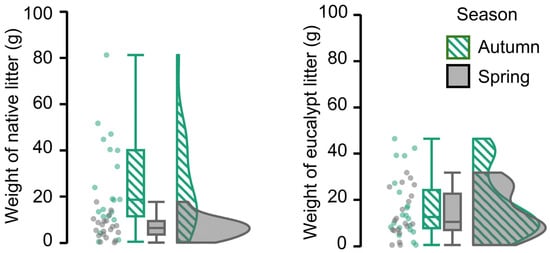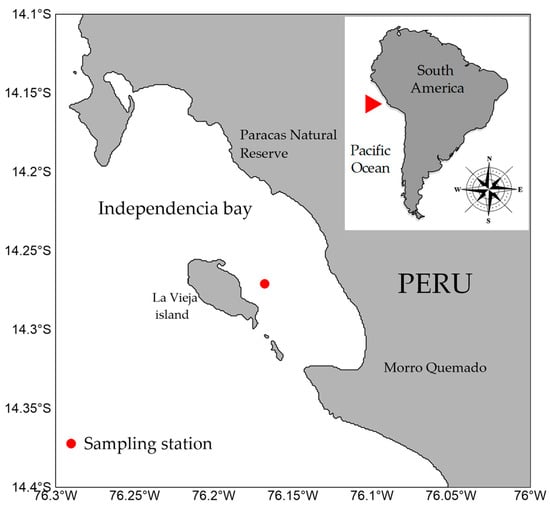-
 AI, GIS, and eDNA for Next-Generation River Health Monitoring
AI, GIS, and eDNA for Next-Generation River Health Monitoring -
 Quantifying Coloration of Threespine Stickleback for Population Analysis: Method Development and Validation
Quantifying Coloration of Threespine Stickleback for Population Analysis: Method Development and Validation -
 A Library of Microsatellite Markers for Efficiently Characterizing the Aquatic Macrophyte Myriophyllum heterophyllum
A Library of Microsatellite Markers for Efficiently Characterizing the Aquatic Macrophyte Myriophyllum heterophyllum -
 Rapid eDNA Identification of Four Aquatic Invasive Species in the Lower Great Lakes
Rapid eDNA Identification of Four Aquatic Invasive Species in the Lower Great Lakes
Journal Description
Hydrobiology
Hydrobiology
is an international, peer-reviewed, open access journal on freshwater and marine biology, limnology, fisheries, oceanography, and aquatic ecology published quarterly online by MDPI.
- Open Access— free for readers, with article processing charges (APC) paid by authors or their institutions.
- High Visibility: indexed within Scopus and other databasaes.
- Journal Rank: CiteScore - Q2 (Agricultural and Biological Sciences (miscellaneous))
- Rapid Publication: manuscripts are peer-reviewed and a first decision is provided to authors approximately 30.8 days after submission; acceptance to publication is undertaken in 5.3 days (median values for papers published in this journal in the first half of 2025).
- Recognition of Reviewers: APC discount vouchers, optional signed peer review, and reviewer names published annually in the journal.
- Hydrobiology is a companion journal of Life.
Latest Articles
Meiofaunal Abundance, Vertical Distribution, and Secondary Production from an Upwelling Coastal Area in Southern Peru (~14°16′ S)
Hydrobiology 2025, 4(4), 31; https://doi.org/10.3390/hydrobiology4040031 - 18 Nov 2025
Abstract
►
Show Figures
Meiofaunal assemblages are crucial components of benthic ecosystems, significantly contributing to organic matter cycling and energy transfer. However, baseline quantitative data from some upwelling systems remain limited. This study characterizes the abundance, vertical distribution, and secondary production of meiofauna at a coastal upwelling
[...] Read more.
Meiofaunal assemblages are crucial components of benthic ecosystems, significantly contributing to organic matter cycling and energy transfer. However, baseline quantitative data from some upwelling systems remain limited. This study characterizes the abundance, vertical distribution, and secondary production of meiofauna at a coastal upwelling station off southern Peru (14°16′ S) for July 2006 (Neutral conditions) and May 2007 (moderate La Niña, LN), using four-replicated sediment cores sectioned into 0–1, 1–2, 2–5, and 5–10 cm layers. While Nematoda (families Desmodoridae, Chromadoridae, Monhysteridae, Oxystominidae, Comesomatidae) dominated the community (>79% in all layers, both years), the total taxonomic richness did not differ substantially between study periods nor across the sediment column for 2006 or for 2007. Total density (0–10 cm) fluctuated between 3916 ± 2202 Ind 10 cm−2 in 2006 and 4203 ± 2274 Ind 10 cm−2 in 2007, with non-significant changes. Biomass (µgC 10 cm−2) in 2006 ranged from 80 ± 24 in the 5–10 cm section to 455 ± 134 in the 2–5 cm section. The uppermost 0–1 cm layer showed 238 ± 155, while the 1–2 cm section reached 302 ± 69. In 2007, biomass was consistently higher in the surface layers, with maximum values in the 1–2 cm section (500 ± 534), followed by the 0–1 cm section (376 ± 34). Hierarchical clustering produced depth-ordered groups with high within-depth similarity (>80–90%). SIMPER results identified Desmodora, Comesomatidae, and Chromadoridae among the top contributors to within-depth similarity and to the dissimilarity observed between surface and subsurface assemblages. A depth-related gradient of community composition was detected, suggesting vertical habitat heterogeneity modulated by several environmental factors; however, PERMANOVA analysis residuals (96.73%) indicate a high variation not explained by ENSO phase, sediment section, or their interaction, suggesting other unmeasured factors explaining meiofaunal community structure. Meiofauna’s production ranged from 2.836 ± 0.049 gC m−2 y−1 in 2006 to 3.106 ± 1.566 gC m−2 y−1 in 2007. These findings expand the limited knowledge on meiofaunal abundance and metabolic demands in this ocean region, fostering future efforts for comparative analyses across latitudes, depth gradients, and oceanographic regimes.
Full article
Open AccessArticle
Evaluation and Economic Analysis of Totally Replacing Soybean Oil with Fish By-Product Oil in Diets for Colossoma macropomum: Effects on Growth, Physiology, and Meat Composition
by
Pedro Alves de Oliveira Filho, João Paulo Ferreira Rufino, Paula Ribeiro dos Santos, Ariany Rabello da Silva Liebl, Harison Santos de Oliveira, Diany Bastos Bezerra, Manoel Pio Nonato Neto, Ana Paula Nunes de Sena, Pedro de Queiroz Costa Neto, Jesaías Ismael da Costa, Jackson Pantoja-Lima, Thyssia Bonfim Araújo da Silva and Adriano Teixeira de Oliveira
Hydrobiology 2025, 4(4), 30; https://doi.org/10.3390/hydrobiology4040030 - 6 Nov 2025
Abstract
Aquaculture faces challenges in reducing feed costs while promoting sustainable use of by-products. This study aimed to evaluate the effects of totally replacing soybean oil (SBO) with fish by-product oil (FBO) in the diet of Colossoma macropomum, focusing on growth performance, physiological
[...] Read more.
Aquaculture faces challenges in reducing feed costs while promoting sustainable use of by-products. This study aimed to evaluate the effects of totally replacing soybean oil (SBO) with fish by-product oil (FBO) in the diet of Colossoma macropomum, focusing on growth performance, physiological and hepatic responses, meat composition, and economic viability. A total of 360 juveniles (9.1 ± 0.59) were distributed in a randomized design with six treatments (0–100% SBO replacement) and six replicates each, and fed to apparent satiation for 91 days. Growth performance did not differ significantly among treatments (p > 0.05), although fish receiving 40% FBO achieved the best feed conversion ratio among treatments. Hematological and biochemical analyses indicated that higher FBO levels (particularly 100%) indicating subtle yet adaptive physiological adjustments, such as moderate modulations in lipid metabolism and erythropoietic activity. Liver weight and hepatosomatic index decreased linearly with increasing FBO levels. In meat composition, FBO inclusion enhanced protein and reduced lipid contents. Although economic indicators were not statistically different (p > 0.05), offered the most favorable trade-off between biological performance and economic efficiency. These findings demonstrate that partial replacement of SBO with FBO, particularly at 40%, represents a sustainable and economically viable alternative for C. macropomum farming.
Full article
(This article belongs to the Special Issue Nutrition–Physiology Interactions in Aquatic Species)
►▼
Show Figures

Figure 1
Open AccessArticle
The Asymptotic Sigmoidal Curve Obtained Through the Multi-Model Approach Provides the Best Description of Growth in Panulirus inflatus Juveniles (Decapoda: Palinuridae)
by
Juan Francisco Arzola-González, Jesús Audomar Landeros-Armenta, José Adán Félix-Ortiz, Yecenia Gutiérrez-Rubio, Martín Ignacio Borrego, Raúl Pérez-González, Jorge Payán-Alejo and Eugenio Alberto Aragón-Noriega
Hydrobiology 2025, 4(4), 29; https://doi.org/10.3390/hydrobiology4040029 - 3 Nov 2025
Abstract
►▼
Show Figures
A mark–recapture experiment was conducted off Mazatlán in the entrance of the Gulf of California to evaluate the growth of juvenile spiny lobsters (Panulirus inflatus). A total of 40 post larvae of spiny lobster were captured, marked, and maintained in plastic
[...] Read more.
A mark–recapture experiment was conducted off Mazatlán in the entrance of the Gulf of California to evaluate the growth of juvenile spiny lobsters (Panulirus inflatus). A total of 40 post larvae of spiny lobster were captured, marked, and maintained in plastic cages for 180 days in seawater off Mazatlán, Sinaloa, Mexico (23°12′32.4″ N 106°25′33.2″ W). Carapace length (CL in mm) was measured. Growth was estimated using the Schnute model, which encompasses four primary cases. In this study, two additional variants equivalent to the von Bertalanffy and Logistic models were also incorporated. These six models were parametrized using normal and log-normal distributions of errors. The selection of the best distribution and best model was based on the Akaike information criterion (AIC). The AIC selected the normal distribution of error and sigmoid-shaped curve as best representative of the growth pattern of juvenile spiny lobster P. inflatus. By identifying the asymptotic sigmoidal curve as the best descriptor of juvenile growth, this study offers a reliable foundation for subsequent assessments of population dynamics, resource management, and aquaculture development of P. inflatus.
Full article

Figure 1
Open AccessArticle
Microalgal Diversity in the Ecuadorian Tropical Andes and Its Association with Abiotic Factors
by
María Cristina Guamán-Burneo, Nory González-Romero and Alex Santillán-Sarmiento
Hydrobiology 2025, 4(4), 28; https://doi.org/10.3390/hydrobiology4040028 - 17 Oct 2025
Abstract
►▼
Show Figures
The Ecuadorian Tropical Andes serve as vital biodiversity hotspots, crucial for hosting and preserving unique endemic species. While numerous taxonomic groups within these hotspots have been extensively studied, microalgae remain relatively unknown. This study aimed to document the microalgal diversity of Tropical Andean
[...] Read more.
The Ecuadorian Tropical Andes serve as vital biodiversity hotspots, crucial for hosting and preserving unique endemic species. While numerous taxonomic groups within these hotspots have been extensively studied, microalgae remain relatively unknown. This study aimed to document the microalgal diversity of Tropical Andean lakes in Ecuador and its relationship with abiotic environmental factors. Water samples were collected from 28 lakes throughout 10 conservation areas, spanning different altitudes in the Ecuadorian Tropical Andes, along with water physical/chemical data. A total of 92 microalgal genera were identified, spanning Bacillariophyta, Chlorophyta, Glaucophyta, Ocrophyta, Cyanophyta, and Euglenophyta. Lakes such as Rodeococha, Anteojos, Chinchillas, Toreadora, Magdalena, and La Mica exhibited the highest richness of microalgal genera. A positive association between temperature and the majority of microalgal phyla, except Glaucophyta, was observed. On the other hand, negative correlations were observed between total dissolved solids and water conductivity with microalgal biodiversity. Additionally, all groups displayed negative associations with pH, except Glaucophyta. The Jaccard similarity index was low among lake communities in agreement with the uniqueness of genera found in some lakes. This study represents a fundamental baseline for future investigations into Ecuador’s microalgal diversity and its relationship with abiotic environmental factors in the delicate freshwater ecosystems of Tropical Andean lakes.
Full article

Figure 1
Open AccessArticle
Morphological and Meristic Feature Studies and Marketing Status of Peregrine Crab Varuna litterata from a Coastal Estuary in Sundarbans Mangrove Forest, Bangladesh
by
Joyanta Bir, Prianka Paul, Wasim Sabbir, Khirujjaman Sumon and Rimu Das
Hydrobiology 2025, 4(4), 27; https://doi.org/10.3390/hydrobiology4040027 - 12 Oct 2025
Abstract
►▼
Show Figures
Varuna litterata is an estuarine crab species widely distributed across the Indo-Pacific region, commonly dwelling in brackish waters, mangrove forests, and tidal estuaries. In Bangladesh, while four Scylla species dominate the commercial crab market, the locally consumed V. litterata remains a biologically overlooked
[...] Read more.
Varuna litterata is an estuarine crab species widely distributed across the Indo-Pacific region, commonly dwelling in brackish waters, mangrove forests, and tidal estuaries. In Bangladesh, while four Scylla species dominate the commercial crab market, the locally consumed V. litterata remains a biologically overlooked gem of the coastal waters. These crabs are frequently captured as a byproduct during shrimp fry collection from coastal estuaries. In this context, the current study investigates the reproductive biology, morphometric dynamics, and market potential of V. litterata collected from the Pasur River, a coastal mangrove forest-adjacent estuary of southern Bangladesh. A total of 75 individuals were collected from March to April 2023, comprising 35 males and 40 females, resulting in a sex ratio of 1:1.14 (♂:♀), with a predominance of females. A visual observation of ovary development revealed four distinct maturation stages, with Stage IV (fully mature) being the most prevalent (43%), indicating peak reproductive activity during the sampling period. Morphometric analysis revealed that the average carapace width (CW) was 31.2 ± 5.7 mm and 31.9 ± 5.8 mm and the mean carapace length (CL) was 29.3 ± 4.7 mm and 30.1 ± 4.9 mm in males and females, respectively. However, the mean body weight (BW) was 13.1 ± 4.3 g in males and 12.7 ± 3.8 g in female crabs. The dominant CW class ranges from 33 to 33.99 mm (males) and 28.99–29.99 mm (females), appear to be the most vulnerable to fishing pressure. BW-CW and CL-CW relationships demonstrated negative allometric growth, with high correlations in both sexes. Significant sexual dimorphism was observed, with males having larger cheliped dimensions, while females had broader abdomens, likely supporting reproductive functions that are essential to their conservation. The marketing of this crab remains largely informal, yet rising local demand and prices highlight its emerging commercial potential. Therefore, incorporation into aquaculture and coastal fishery development of this crab species could enhance food security, support livelihoods, and contribute to sustainable blue economy initiatives in Bangladesh.
Full article

Figure 1
Open AccessArticle
Environmental DNA (eDNA) Surveillance of Zebra Mussels (Dreissena polymorpha) in Lake Lanier, Georgia: A Model for Early Detection and Public Engagement
by
Larry L. Bowman, Jr., Amy L. Rodriguez, Hannah Fontenot and Margi Flood
Hydrobiology 2025, 4(4), 26; https://doi.org/10.3390/hydrobiology4040026 - 7 Oct 2025
Abstract
►▼
Show Figures
Environmental DNA (eDNA) detection has emerged as a powerful, non-invasive tool for identifying aquatic organisms, particularly those that are rare, elusive, or invasive. Dreissena polymorpha (zebra mussel) is an invasive bivalve posing ecological and economic threats to North American freshwater systems. In April
[...] Read more.
Environmental DNA (eDNA) detection has emerged as a powerful, non-invasive tool for identifying aquatic organisms, particularly those that are rare, elusive, or invasive. Dreissena polymorpha (zebra mussel) is an invasive bivalve posing ecological and economic threats to North American freshwater systems. In April 2021, zebra mussels were discovered attached to a boat destined for Lake Sidney Lanier in North Georgia—a high-use recreational reservoir with no prior reports of infestation. To determine whether D. polymorpha had been introduced, we implemented a biomonitoring protocol leveraging eDNA collection and PCR-based detection. Sampling was conducted during summer 2022 across high-risk marina sites and potential habitats. Positive controls from the Tennessee River yielded expected results, while Lake Lanier samples showed no evidence of zebra mussel DNA. Our results validate using eDNA methodology for proactive biomonitoring and highlight the importance of molecular surveillance and community outreach to prevent the establishment of invasive species in vulnerable aquatic systems. This study demonstrates the utility of a scalable, replicable early detection framework that can be adopted by educational institutions, natural resource agencies, and community groups to mitigate the risk of biological invasions.
Full article

Figure 1
Open AccessArticle
No Nets, No Shocks, No Problem: Assessing Replicability and Disturbance Effects in Fish Monitoring Using Remote Video Cameras in Low Order Streams
by
Abigail Archi, Jaclyn M. H. Cockburn and Paul V. Villard
Hydrobiology 2025, 4(4), 25; https://doi.org/10.3390/hydrobiology4040025 - 24 Sep 2025
Abstract
►▼
Show Figures
Conventional fish population sampling methods such as electrofishing and netting, pose risks to fish and are often restricted to small, shallow headwater streams—especially where endangered species may be present. Additionally, non-capture surveying (e.g., snorkelling) can disturb fish and make observation more challenging. This
[...] Read more.
Conventional fish population sampling methods such as electrofishing and netting, pose risks to fish and are often restricted to small, shallow headwater streams—especially where endangered species may be present. Additionally, non-capture surveying (e.g., snorkelling) can disturb fish and make observation more challenging. This study evaluates the effectiveness and reproducibility of remote underwater video (RUV) surveys in a shallow (<0.5 m deep), freshwater stream. Additionally, fish response to disturbances (e.g., shadows, noise, surface disruptions) were characterized. Fish abundance was estimated by maxN (maximum number of individuals observed in a single frame) and used multiple cameras placed in the same habitat (pool). Findings indicated a high consistency in maxN when fish numbers were low (<5 individuals), with increasing variability at higher numbers (>15 individuals). This suggests that single camera setups can reliably detect minimum abundance. Fish responses to four disturbances (e.g., shadows, noise, surface disruptions, mink) were noted throughout. Typically, these responses were short-lived, with fish returning to pre-disturbance maxN values within minutes, with the most significant response to researcher-induced disturbance occurring immediately after RUV deployment. Overall, RUVs proved effective for passive, non-capture fish monitoring in shallow, sensitive habitats, producing replicable data with minimal impact caused by researcher disturbance. This technique can be added to our toolboxes for studying small-bodied fishes in challenging environments.
Full article

Figure 1
Open AccessArticle
Ontogenetic Phase Shifts in Metabolism and Intraspecific Scaling in a Non-Teleost Fish, the Sterlet Sturgeon (Acipenser ruthenus)
by
Dong In Kim
Hydrobiology 2025, 4(3), 24; https://doi.org/10.3390/hydrobiology4030024 - 10 Sep 2025
Abstract
►▼
Show Figures
Metabolism is fundamental to many biological processes that govern the flow of energy and materials within organisms. Recently, several interspecific studies have suggested that ontogenetic phase shifts in the metabolism of teleost fish coincide with body mass increases during early development. The morphological
[...] Read more.
Metabolism is fundamental to many biological processes that govern the flow of energy and materials within organisms. Recently, several interspecific studies have suggested that ontogenetic phase shifts in the metabolism of teleost fish coincide with body mass increases during early development. The morphological and behavioral changes that accompany these metabolic shifts could explain differences in intraspecific size scaling metabolism, but it remains unclear whether these shifts are widespread in a variety of aquatic organisms, including non-teleost fish. Here, a metabolic study in sterlet sturgeon (Acipenser ruthenus) was conducted to examine whether the ontogenetic phase shifts in metabolism coincide with growth in a non-teleost fish. The results were also compared with previously published metabolic scaling data for the Japanese flounder (Paralichthys olivaceus) to explore differences in intraspecific scaling patterns. The present study revealed that ontogenetic phase shifts in metabolism do occur in sterlet sturgeon. These findings indicate that non-teleost fish likely undergo scaling mechanisms in metabolism similar to those of teleost fish.
Full article

Figure 1
Open AccessArticle
Effects of Long-Term Urban Light Pollution and LED Light Color Temperature on the Behavior of a Holarctic Amphipod Gammarus lacustris Sars, 1863
by
Yana Ermolaeva, Maria Maslennikova, Dmitry Golubets, Arina Lavnikova, Natalia Kulbachnaya, Sofya Biritskaya, Anastasia Solodkova, Ivan Kodatenko, Artem Guliguev, Diana Rechile, Kirill Salovarov, Anastasia Olimova, Darya Kondratieva, Anna Solomka, Alyona Slepchenko, Alexandr Bashkirtsev, Dmitry Karnaukhov and Eugene Silow
Hydrobiology 2025, 4(3), 23; https://doi.org/10.3390/hydrobiology4030023 - 3 Sep 2025
Abstract
►▼
Show Figures
Light pollution is becoming more widespread every year, accompanied by the active use of LED lighting. Currently, the ability of organisms to adapt to this pollution and the potential impact of LED lighting of different color temperatures and intensities on organisms remains poorly
[...] Read more.
Light pollution is becoming more widespread every year, accompanied by the active use of LED lighting. Currently, the ability of organisms to adapt to this pollution and the potential impact of LED lighting of different color temperatures and intensities on organisms remains poorly understood. In this study, we aimed to find out how long-term light pollution affects the behavior of amphipods Gammarus lacustris, and to compare their locomotor activity under different lighting conditions, taking into account the factor of shelter from light. The response of individuals was compared in group and individual experiments under daylight, without light, warm and cold LED light up to 30 lx. The individuals were from two populations: the first is not exposed to light pollution (lake No. 14), while the second is affected (the Angara River within the city of Irkutsk). The locomotor activity of amphipods was assessed in daylight, without light, warm and cold light of 2–2.5 lx and 10–11 lx in the presence and absence of shelters from light. As a result of the experiments, adaptive changes in the reaction of G. lacustris to warm light were identified in individuals from the Angara River. The importance of LED light color temperature and warm light intensity in determining amphipod response to light was also confirmed. It was found that warm and cold light have different effects on the behavior of G. lacustris, and the presence of shelters from light can reduce the negative impact of light pollution in natural conditions.
Full article

Figure 1
Open AccessArticle
Working Primers and qPCR Protocols for Rapid eDNA Identification of Four Aquatic Invasive Species Found in the Lower Great Lakes with High Potential for Ballast Transport to Lake Superior
by
Matthew E. Gruwell, Amanda Welsbacher, Noel Moore, Allegra Cangelosi, Abigail Melendez, Ryan Sheehan and Ivor Knight
Hydrobiology 2025, 4(3), 22; https://doi.org/10.3390/hydrobiology4030022 - 19 Aug 2025
Abstract
►▼
Show Figures
Reliable, timely and economical target organism detection in harbors and ballast water is urgently needed to prevent the spread of aquatic invasive species (AIS) by commercial ships in the North American Great Lakes (NAGL). Inter-Great Lake ships (Lakers) transport large volumes (ca. 52
[...] Read more.
Reliable, timely and economical target organism detection in harbors and ballast water is urgently needed to prevent the spread of aquatic invasive species (AIS) by commercial ships in the North American Great Lakes (NAGL). Inter-Great Lake ships (Lakers) transport large volumes (ca. 52 million metric tons. annually) of untreated lake water between lakes, with over 50% transported against the natural flow from the lower lakes to Western Lake Superior ports. The transport of ballast water is the number one threat of AIS spread throughout the NAGL. A relatively new tool to fight the spread of AIS is the use of eDNA for rapid detection and identification of target organisms. This technology opens doors for advancing control of ballast-mediated AIS through rapid detection. To that end, we have developed species-specific, reliable eDNA primers to target specific detection of four AIS in water samples along with qPCR protocols. Target organisms were selected based on the following criteria: (1) they are known to be invasive in the lower NAGL, (2) they are established in the lower NAGL but not in Superior, (3) they are biodegradable, and (4) they are obtainable, morphologically distinct and have existing DNA sequence information. Working primers, qPCR protocols and detection limits are provided for three invertebrate species and one alga species. These species are Daphnia lumholtzi (a water flea), Cercopagis pengoi (the fishhook water flea), Echinogammarus ishnus (a scud) and Nitellopsis obtusa (Starry Stonewort).
Full article

Figure 1
Open AccessBrief Report
A Library of Microsatellite Markers for Efficiently Characterizing the Aquatic Macrophyte Myriophyllum heterophyllum
by
Lucas E. Bernacki
Hydrobiology 2025, 4(3), 21; https://doi.org/10.3390/hydrobiology4030021 - 15 Aug 2025
Abstract
Myriophyllum heterophyllum is an aquatic macrophyte that is invasive to the northeastern United States and several western European countries. Spreading by vegetative clonal propagation, especially fragmentation, extensive resources are devoted to limiting its growth and spread; however, genetic assessments are not typically included
[...] Read more.
Myriophyllum heterophyllum is an aquatic macrophyte that is invasive to the northeastern United States and several western European countries. Spreading by vegetative clonal propagation, especially fragmentation, extensive resources are devoted to limiting its growth and spread; however, genetic assessments are not typically included in management strategies. Reduction in genetic (clonal) diversity should accompany biomass reduction, yet without genetic assessment, the efficacy of plant removal remains unclear. This paper is the first to describe a microsatellite marker library and its use in the characterization of Myriophyllum heterophyllum. Eighty-seven tissue samples were collected across the invasive distribution of Myriophyllum heterophyllum in Maine, USA. DNA was extracted, and PCR amplification was employed to screen 13 published microsatellites. Sequencing of the amplified loci was performed to characterize repeat motifs and confirm primer binding sites. Fragment sizing of PCR amplicons was employed to determine microsatellite lengths across the 87 samples. A total of 7 of the 13 tested markers were amplified, with six of those seven found to be variable. Polyploidy was evident from allelic diversity within individuals, although precise ploidy could not be determined. Observed heterozygosity ranged from 0.16 to 1.00 across variable markers. This seven-marker library was effective in characterizing the genetic diversity of both newly discovered (<5 years) and older (>50 years) infestations and is expected to be suitable for assessment of genetic diversity in populations within the native range of M. heterophyllum. The marker library also shows potential for use in several other Myriophyllum species.
Full article
Open AccessArticle
Quantifying Threespine Stickleback Gasterosteus aculeatus L. (Perciformes: Gasterosteidae) Coloration for Population Analysis: Method Development and Validation
by
Ekaterina V. Nadtochii, Anna S. Genelt-Yanovskaya, Evgeny A. Genelt-Yanovskiy, Mikhail V. Ivanov and Dmitry L. Lajus
Hydrobiology 2025, 4(3), 20; https://doi.org/10.3390/hydrobiology4030020 - 31 Jul 2025
Abstract
►▼
Show Figures
Fish coloration plays an important role in reproduction and camouflage, yet capturing color variation under field conditions remains challenging. We present a standardized, semi-automated protocol for measuring body coloration in the popular model fish threespine stickleback (Gasterosteus aculeatus). Individuals are photographed
[...] Read more.
Fish coloration plays an important role in reproduction and camouflage, yet capturing color variation under field conditions remains challenging. We present a standardized, semi-automated protocol for measuring body coloration in the popular model fish threespine stickleback (Gasterosteus aculeatus). Individuals are photographed in a controlled light box within minutes of capture, and color is sampled from eight anatomically defined standard sites in human-perception-based CIELAB space. Analyses combine univariate color metrics, multivariate statistics, and the ΔE* perceptual difference index to detect subtle shifts in hue and brightness. Validation on pre-spawning fish shows the method reliably distinguishes males and females well before full breeding colors develop. Although it currently omits ultraviolet signals and fine-scale patterning, the approach scales efficiently to large sample sizes and varying lighting conditions, making it well suited for population-level surveys of camouflage dynamics, sexual dimorphism, and environmental influences on coloration in sticklebacks.
Full article

Figure 1
Open AccessReview
Next-Generation River Health Monitoring: Integrating AI, GIS, and eDNA for Real-Time and Biodiversity-Driven Assessment
by
Su-Ok Hwang, Byeong-Hun Han, Hyo-Gyeom Kim and Baik-Ho Kim
Hydrobiology 2025, 4(3), 19; https://doi.org/10.3390/hydrobiology4030019 - 16 Jul 2025
Cited by 1
Abstract
Freshwater ecosystems face escalating degradation, demanding real-time, scalable, and biodiversity-aware monitoring solutions. This review proposes an integrated framework combining artificial intelligence (AI), geographic information systems (GISs), and environmental DNA (eDNA) to overcome these limitations and support next-generation river health assessment. The AI-GIS-eDNA system
[...] Read more.
Freshwater ecosystems face escalating degradation, demanding real-time, scalable, and biodiversity-aware monitoring solutions. This review proposes an integrated framework combining artificial intelligence (AI), geographic information systems (GISs), and environmental DNA (eDNA) to overcome these limitations and support next-generation river health assessment. The AI-GIS-eDNA system was applied to four representative river basins—the Mississippi, Amazon, Yangtze, and Danube—demonstrating enhanced predictive accuracy (up to 94%), spatial pollution mapping precision (85–95%), and species detection sensitivity (+18–30%) compared to conventional methods. Furthermore, the framework reduces operational costs by up to 40%, highlighting its potential for cost-effective deployment in low-resource regions. Despite its strengths, challenges persist in the areas of regulatory acceptance, data standardization, and digital infrastructure. We recommend legal recognition of AI and eDNA indicators, investment in explainable AI (XAI), and global data harmonization initiatives. The integrated AI-GIS-eDNA framework offers a scalable and policy-relevant tool for adaptive freshwater governance in the Anthropocene.
Full article
(This article belongs to the Special Issue Ecosystem Disturbance in Small Streams)
►▼
Show Figures

Figure 1
Open AccessArticle
Ecological Status Should Be Considered When Evaluating and Mitigating the Effects of River Connectivity Losses in European Rivers
by
António Tovar Faro, Gonçalo Duarte, Tamara Leite, Maria Teresa Ferreira and Paulo Branco
Hydrobiology 2025, 4(3), 18; https://doi.org/10.3390/hydrobiology4030018 - 1 Jul 2025
Abstract
►▼
Show Figures
The deterioration of European freshwater ecosystems, driven by habitat fragmentation and connectivity loss, seriously threatens biodiversity and ecosystem integrity. While restoration efforts often focus on reconnecting river networks, ecological assessments tend to overlook the broader concept of connectivity. This study highlights the need
[...] Read more.
The deterioration of European freshwater ecosystems, driven by habitat fragmentation and connectivity loss, seriously threatens biodiversity and ecosystem integrity. While restoration efforts often focus on reconnecting river networks, ecological assessments tend to overlook the broader concept of connectivity. This study highlights the need to incorporate ecological quality into connectivity assessments, ensuring more effective restoration that is aligned with European Union (EU) conservation policies. Using the dendritic connectivity index for potamodromous (DCIp) species, we analysed seven connectivity scenarios, integrating natural and artificial barriers to assess both structural connectivity and quality-weighted connectivity. These scenarios included: (1) structural connectivity considering only natural barriers (S_NB) and (2) all barriers (S_AB); (3) quality-weighted connectivity considering natural barriers (W_NB), and (4) all barriers (W_AB); three enhanced scenarios considering all barriers with (5) improved quality (W_AB_IQ), (6) improved probability of connectivity (W_AB_IC), and (7) improved quality and probability of connectivity (W_AB_IQC). Connectivity values varied across scenarios, with the natural baseline (S_NB) showing the highest connectivity values (mean = 0.98). When the natural baseline was weighted by the GES probability (W_NB), connectivity values dropped considerably (mean = 0.30). Incorporating all barriers (W_AB) further reduced the connectivity values (mean = 0.26). The improved scenario W_AB_IQC showed notable connectivity improvements (mean = 0.40). This study underscores the importance of integrating ecological quality into river connectivity assessments. It demonstrates that restoring habitat quality alongside connectivity restoration can substantially enhance river ecosystems. Prioritising restoration in high-quality areas maximises ecological and social benefits, supports sustainable river management, improves connectivity, and promotes biodiversity conservation.
Full article

Figure 1
Open AccessArticle
Effects of Cumulative Municipal Wastewater Exposure on Benthic Macroinvertebrate Assemblages: An Experimental Stream Approach
by
Aphra M. Sutherland, Frederick J. Wrona and David C. Barrett
Hydrobiology 2025, 4(2), 17; https://doi.org/10.3390/hydrobiology4020017 - 13 Jun 2025
Abstract
►▼
Show Figures
Municipal wastewater effluent (MWWE) is a common source of nutrient enrichment and provides a route for emerging substances of concern (ESOCs) to enter aquatic systems. Community composition and abundance metrics of benthic macroinvertebrates are commonly utilized to assess ecological impacts associated with nutrient
[...] Read more.
Municipal wastewater effluent (MWWE) is a common source of nutrient enrichment and provides a route for emerging substances of concern (ESOCs) to enter aquatic systems. Community composition and abundance metrics of benthic macroinvertebrates are commonly utilized to assess ecological impacts associated with nutrient enrichment; however, the responses of these metrics in systems with diverse chemical mixtures from MWWE, are not well understood. This study specifically addresses the effects of cumulative loading of tertiary-treated MWWE through responses in benthic macroinvertebrate communities in experimental control and treatment streams. Treatment streams used source river water previously exposed to upstream wastewater treatment plants but with an additional 5% by volume tertiarily treated MWWE, while control streams used only source river water. Surbers and artificial substrate rock baskets were used to examine impacts on both established and colonizing benthic communities, respectively. No significant differences were observed between the control and treatment streams in any of the community metrics of well-established benthic communities. In contrast, significant decreases in colonizing taxon diversity and evenness were found between treatment and control streams. The dominant taxa (most abundant family, by percentage of sample) in the community, often filter feeders, significantly increased in percentage of the total community in treatment streams. This response was consistent with a nutrient enrichment effect, with no evidence of ESOC related toxicity. This study highlights the need for bioassessment programs to utilize approaches involving varied in-situ sampling methods and controlled exposure systems to gain a better understanding of how various stages of community-level development are impacted by urban pollutants such as MWWE.
Full article

Figure 1
Open AccessEditor’s ChoiceArticle
Eucalyptus globulus Afforestation Reduces Invertebrate Richness and Diversity in Streams
by
Anais Rivas-Torres, Manuel A. S. Graça, Andrea Landeira-Dabarca, Maruxa Álvarez, Leandro Juen and Adolfo Cordero-Rivera
Hydrobiology 2025, 4(2), 16; https://doi.org/10.3390/hydrobiology4020016 - 12 Jun 2025
Abstract
►▼
Show Figures
Intensive forestry, particularly the establishment of monospecific plantations with exotic species, can deeply impact the ecological functioning of forest streams, where riparian leaf litter is the primary source of energy. In this study, we investigated the effects of Eucalyptus globulus afforestation on macroinvertebrate
[...] Read more.
Intensive forestry, particularly the establishment of monospecific plantations with exotic species, can deeply impact the ecological functioning of forest streams, where riparian leaf litter is the primary source of energy. In this study, we investigated the effects of Eucalyptus globulus afforestation on macroinvertebrate communities in 20 streams in Galicia (NW Spain) with varying levels of accumulated eucalypt leaf litter. Sampling was done in autumn 2020 and spring 2021. In autumn, six streams had leaf litter composed of >50% of eucalypt leaves, a proportion that increased to 12 streams in spring. A total of 24,705 individuals were found in autumn and 12,529 in spring, belonging to 125 taxa. Although some taxa decreased their abundance with an increase in the proportion of eucalypt litter, variability in overall macroinvertebrate abundance was mainly explained by season, stream flow, and water temperature. However, species richness and diversity were significantly lower in streams mainly subsided by Eucalyptus litter compared to those dominated by native riparian vegetation. Macroinvertebrate abundance, richness, and diversity peaked in autumn, coinciding with the influx of deciduous litterfall and lower proportion of eucalypt litter. The lower quality, low-nutrient content, and presence of feeding deterrents in Eucalyptus leaf litter compared to native deciduous tree species likely drive these observed patterns, underscoring the importance of preserving native riparian forests to sustain stream biodiversity, even in managed landscapes dominated by Eucalyptus plantations.
Full article

Figure 1
Open AccessEditor’s ChoiceArticle
Key Habitat and Predatory Influences on the Community- and Species-Level Population Dynamics of Spring-Breeding Amphibian Larvae Within a Remnant Tupelo-Cypress Wetland
by
Jacob M. Hutton and Robin W. Warne
Hydrobiology 2025, 4(2), 15; https://doi.org/10.3390/hydrobiology4020015 - 30 May 2025
Cited by 1
Abstract
►▼
Show Figures
Understanding the factors influencing amphibian populations is essential for effective freshwater conservation, particularly for species with biphasic life histories. This study examined how pond- and landscape-level characteristics shape larval amphibian occupancy, abundance, and detection in a remnant Tupelo-Cypress wetland in southeastern Illinois. Given
[...] Read more.
Understanding the factors influencing amphibian populations is essential for effective freshwater conservation, particularly for species with biphasic life histories. This study examined how pond- and landscape-level characteristics shape larval amphibian occupancy, abundance, and detection in a remnant Tupelo-Cypress wetland in southeastern Illinois. Given the small number of available ponds (n = 4), we standardized survey effort across sites and incorporated robust hierarchical Bayesian models to evaluate environmental effects at both community and species levels. Occupancy probabilities were generally high across species, with canopy cover significantly increasing both community and species occupancy, particularly for salamanders (up to 6.4-fold). Predatory backswimmers and fish substantially reduced occupancy (by 21.7-fold and 6.0-fold, respectively). Anurans, especially Pseudacris spp., were more abundant than salamanders, with abundance positively associated with canopy cover, leaf litter, and pond perimeter. Detection probabilities were generally low and varied by species, with predatory invertebrates reducing detection up to 83.3-fold. These findings underscore the importance of maintaining canopy cover while mitigating predation risks to support amphibian populations. The application of multi-species hierarchical models provides a nuanced understanding of species-specific responses, offering valuable insights for conservation strategies in regions affected by habitat loss and climate change. However, given the limited spatial replication, these findings should be interpreted cautiously and validated through additional studies across broader temporal and spatial scales.
Full article

Figure 1
Open AccessArticle
Defense Limitations of Single Parents in the Biparental Convict Cichlid Fish: A Field Study
by
Layla Al-Shaer, Brandon Baumann and Murray Itzkowitz
Hydrobiology 2025, 4(2), 14; https://doi.org/10.3390/hydrobiology4020014 - 21 May 2025
Abstract
►▼
Show Figures
A field study on the biparental convict cichlids (Amatitlania siquia) in Lake Xiloá, Nicaragua was conducted to understand how the loss of a parent’s parental care affects the antipredator behavior of both parents and offspring during intruder events. We hypothesized that
[...] Read more.
A field study on the biparental convict cichlids (Amatitlania siquia) in Lake Xiloá, Nicaragua was conducted to understand how the loss of a parent’s parental care affects the antipredator behavior of both parents and offspring during intruder events. We hypothesized that the combined efforts of two parents would result in increased intruder aggression and decreased offspring dispersion compared to single-parents of either sex, and that single-females and males would differ in their ability to deter predators and manage offspring dispersion. Both parents in a pair chased half the intruders that single-females did and the same number as single-males, suggesting that the presence of a partner deters intruders from encroaching and affords parents more time to engage in other parental care duties. Compared to single-parents, offspring accompanied by both parents were seldom left alone and showed greater shoal cohesion—both of which would presumably lower their risk of predation. Although there were sex differences between single-parents in terms of how often they left their offspring unattended and called to them using pelvic fin-flicks, neither sex was found to be more effective at managing the distribution of their offspring. This field study provides empirical evidence to support the need for biparental care in this species and gives insight into the selection pressures shaping parental investment.
Full article

Figure 1
Open AccessArticle
The Diversity and Biochemical Composition of Zooplankton as a Potential Indicator of Dietary Requirements for Pikeperch Larvae (Sander lucioperca)
by
Anatoliy Lyutikov, Alexander Korolev, Artem Trifonov, Anastasia Zubareva and Artem Nedoluzhko
Hydrobiology 2025, 4(2), 13; https://doi.org/10.3390/hydrobiology4020013 - 6 May 2025
Abstract
►▼
Show Figures
Freshwater fish species play an important role in global aquaculture. Currently, sturgeon, carp, and tilapia are at the forefront of this industry. However, as human populations continue to grow, the demand for new sources of animal protein increases, making the use of other
[...] Read more.
Freshwater fish species play an important role in global aquaculture. Currently, sturgeon, carp, and tilapia are at the forefront of this industry. However, as human populations continue to grow, the demand for new sources of animal protein increases, making the use of other freshwater species in aquaculture essential. The pikeperch (Sander lucioperca) is one of the most promising fish species for European aquaculture, but its usage has been hindered by a lack of effective larval-rearing protocols. Most studies focus on using cultured or nutrient-rich zooplankton for larval cultivation, while natural zooplankton from the local environment are rarely used. In this study, we aim to investigate the nutritional requirements of pikeperch larvae by describing the taxonomic diversity and biochemical composition of zooplankton collected from a natural oligotrophic lake in Northwest Russia. The chemical composition of zooplankton is characterized by a high protein content (up to 70% of dry matter), a moderate lipid content (up to 25%), and a deficiency of certain fatty acids and amino acids. Specifically, there is a low concentration of docosahexaenoic acid and methionine. The dry matter content in the zooplankton averages 10%, with nitrogen-free extracts accounting for 4% and ash making up 4%. These biochemical parameters meet the nutritional requirements of freshwater pikeperch larvae, with the notable exception of the lower levels of DHA and methionine, which are typically characteristic of freshwater zooplankton. This information sheds light on the nutritional requirements of pikeperch larvae and the development of more efficient rearing methods.
Full article

Figure 1
Open AccessArticle
Reasons for the Decline in Catches as Revealed by Long-Term Data from the Actual Operation of the Sea Urchin Fishery Hemicentrotus pulcherrimus in Mikuni, Fukui Prefecture, Japan
by
Daichi Nakano
Hydrobiology 2025, 4(2), 12; https://doi.org/10.3390/hydrobiology4020012 - 19 Apr 2025
Abstract
►▼
Show Figures
Dive fisheries are widely practiced in coastal areas worldwide owing to their minimal equipment requirements and extensive historical background. Female divers in Korea and Japan have extensive knowledge of the local coastal environment and engage in sustainable fishing practices. However, the number of
[...] Read more.
Dive fisheries are widely practiced in coastal areas worldwide owing to their minimal equipment requirements and extensive historical background. Female divers in Korea and Japan have extensive knowledge of the local coastal environment and engage in sustainable fishing practices. However, the number of divers and their catches has been declining. In this study, long-term catch and effort data were collected to investigate the reasons for the decline in the catch of the sea urchin, Hemicentrotus pulcherrimus, in Mikuni, Sakai City, Fukui Prefecture, Japan. A significant correlation was observed between catch and effort, and the main reason for the decline in catch was a reduction in fishing effort. Fishermen have voluntarily limited their fishing efforts to prevent the depletion of natural stocks, and a decrease in the number of fishermen has contributed to this reduction. In addition, regulations on catchable size and fishing season were implemented. However, natural stocks appear to have declined. Although sea urchin fisheries have been sustainably practiced for a long time, current fishery management and regulations appear inadequate. Therefore, sustainable fishing requires identifying the factors that affect stock fluctuations and updating management practices.
Full article

Figure 1
Highly Accessed Articles
Latest Books
E-Mail Alert
News
Topics
Topic in
Agriculture, Agronomy, Gastronomy, Grasses, Sustainability, Diversity, Horticulturae, Hydrobiology
Mediterranean Biodiversity, 2nd Edition
Topic Editors: Luigi De Bellis, Massimiliano Renna, Pietro Buzzini, Ignasi TorreDeadline: 15 December 2025
Topic in
Biology, Data, Diversity, Fishes, Animals, Conservation, Hydrobiology
Intersection Between Macroecology and Data Science
Topic Editors: Paulo Branco, Gonçalo DuarteDeadline: 23 April 2027
Topic in
Toxins, Water, JMSE, Oceans, Hydrobiology, Environments
Recent Advances in Harmful Algal Blooms in Freshwater and Marine Systems
Topic Editors: Patricio A. Díaz, Gonzalo ÁlvarezDeadline: 31 July 2027

Conferences
Special Issues
Special Issue in
Hydrobiology
Long-Term Dynamics of Biodiversity in Aquatic Environments
Guest Editor: Emilie Saulnier-TalbotDeadline: 31 December 2025
Special Issue in
Hydrobiology
Nutrition–Physiology Interactions in Aquatic Species
Guest Editors: Dizhi Xie, Songlin Li, Kangle LuDeadline: 30 January 2026
Special Issue in
Hydrobiology
Impact of Environmental Changes on Freshwater Ecosystems
Guest Editor: Andrew B.H. ReesDeadline: 28 February 2026
Special Issue in
Hydrobiology
Water Pollution Solutions: From Ecological Risk Assessment to Biological Restoration
Guest Editor: Lei WangDeadline: 31 March 2026









